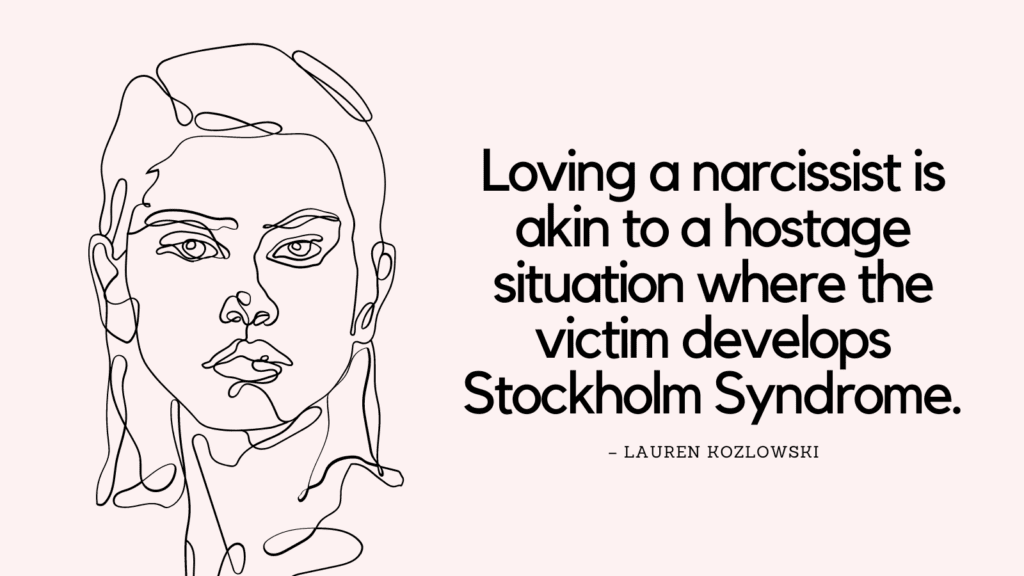This post contains some of the best Stockholm syndrome quotes.
What Is Stockholm Syndrome?
Stockholm Syndrome refers to a psychological phenomenon in which a person develops feelings of trust, affection, and empathy towards their captors or abusers, often as a result of trauma or abuse.
Stockholm Syndrome typically occurs in situations where a victim is held captive by their abuser for an extended period of time and may feel that they have no means of escape.
The term “Stockholm Syndrome” was first used in the 1970s by criminologist and psychiatrist Nils Bejerot after a bank robbery and hostage situation in Stockholm, Sweden.
During the event, the hostages began to sympathize with their captors and later defended them in court.
People who experience Stockholm Syndrome may become emotionally attached to their abusers, form a sense of loyalty, and exhibit behaviors such as defending or protecting their abusers from authorities or other victims.
The syndrome is often seen as a coping mechanism, a way for victims to survive traumatic situations by identifying and bonding with their abusers.
However, it is important to note that not all victims of abuse or trauma will develop Stockholm Syndrome.
Treatment for Stockholm Syndrome usually involves therapy and counseling to help the individual process their experiences, address any underlying mental health concerns, and learn healthy coping mechanisms for dealing with trauma and stress.
Stockholm Syndrome Quotes
1. “As an aside, I found out that people with Stockholm syndrome tend to show some of the same symptoms as those who have post-traumatic stress syndrome.” – Lauren Kozlowski
2. “I think the syndrome is fascinating, not only because I find it comparable with my own situation, but because it goes to show the power a human being can have over another, and the irrational and illogical behaviors it incites from the victims.” – Lauren Kozlowski
3. “In Stockholm, the hostages were critical and abusive toward the rescuers.” – Patrick J. Carnes
4. “Like the way Stockholm Syndrome manifests in an individual, a victim of abuse bonds with their abuser as both the source of fear and comfort in an attempt to survive the relationship. As a result, the victim then feels a misplaced (yet hugely unwavering) sense of loyalty and commitment to their abusers, which to an uneducated outsider often appears utterly nonsensical.” – Lauren Kozlowski
Related: Top 10 Signs Of Trauma Bonding & How To Heal A Trauma Bond
5. “Loving a narcissist is akin to a hostage situation where the victim develops Stockholm Syndrome.” – Lauren Kozlowski
6. “One of the phrases used by clinicians to describe traumatic bonding is the “Stockholm Syndrome.” In 1973, a bank robbery occurred in Stockholm in which hostages were taken as a way to force authorities to release some prisoners. The hostage takers were threatening and abusive to their hostages. There were, however, also moments in which they performed little acts of kindness for the hostages. And they presented themselves as having a noble cause. Yet they were also clear that they would kill the hostages if forced to by the authorities. The five-and-a-half-day siege ended with the hostages and hostage takers holed up in the bank vault. That the captors capitulated was not a surprise. However, what astounded everyone was: (1) the obvious and total cooperation of the hostages; (2) the deep caring the hostages felt for their captors; and (3) the hostage’s rage and contempt for those who rescued them. When arrested, the captors left the bank with hugs and kisses and with promises of support, loyalty and care from the hostages.” – Patrick J. Carnes
7. “People who exhibit the symptoms of Stockholm syndrome often become very protective of their captors or abusers, even in some cases where they’ve foiled the authorities’ efforts to rescue them.” – Lauren Kozlowski
8. “Stockholm syndrome is something that develops when people find themselves in a situation where they have an intense fear of harm or physical injury and believe that all control is solely in the hands of their abuser. The psychological response that follows this, after a period of time, is an instinctive survival strategy for the victim. It shows the abused individual offering sympathy and support for their abuser’s plight and can even begin to feel negative feelings toward those who are trying to help remove the victim from the situation.” – Lauren Kozlowski
9. “The captors created the right chemistry of loving care alternated with violence, threats and degrading behavior. After serving ten-year prison terms, both hostage takers married woman hostages from the bank. These women knew these men less than a week but were willing, on the basis of their hostage experience, to wait for a decade to commit for a lifetime. All of this was celebrated in a double ceremony attended by many fellow hostages.” – Patrick J. Carnes
Related: 7 Stages Of Trauma Bonding (+FREE Worksheets)
10. “The fact that Stockholm syndrome is a survival mechanism really intrigues me, and researching this topic after I’d endured similar symptoms was something I found enlightening and cathartic.” – Lauren Kozlowski
11. “The name ‘Stockholm syndrome’ originated from a 1973 bank robbery in Stockholm, Sweden, where four hostages were held for a total of six days. During their imprisonment, and fully in the firing line of harm, the hostages seemed to defend the actions of their captors. The captives even seemed to scold efforts by the government to rescue them from the situation. They pleaded with the authorities for their captors not to be harmed during the rescue and engineered ways for that to happen. Following the incident, and after being rescued, the victims couldn’t explain their feelings of sympathy and lack of anger toward their captors. Months after their hostage ordeal had ended, the victims of the bank robbery were continuing to show their loyalty to the robbers. They refused to testify against them and helped the robbers raise funds for legal fees. They even went as far as to visit them whilst they were in prison. This just goes to show how powerful the bond that Stockholm syndrome creates is, much like the all-consuming bond that can manifest in a narcissistic relationship.” – Lauren Kozlowski
12. “The syndrome is not actually a named disease – you won’t find this in any manual. It’s rather a way to describe the behaviors of those who’ve been repeatedly traumatized over a period of time.” – Lauren Kozlowski
13. “Trauma bonding and Stockholm Syndrome have a lot of similarities, and the symptoms and methods used by the abuser often run parallel to that of trauma bonding.” – Lauren Kozlowski
Related: Relationship Red Flags Quiz
14. “Victims of the syndrome tend to suffer from severe isolation as well as emotional and physical abuse from the captor. As you know, isolation and abuse are also demonstrated in the situations of battered spouses, emotional abuse victims, as well as abused children – each of these circumstances can up with the victim or victims responding in an extremely compliant and supportive way as a method for survival.” – Lauren Kozlowski
15. “Whilst it’s commonly reported that hostages and kidnapping victims exhibit the behaviors associated with the syndrome, so can people who are (or have been) in abusive relationships or a member of a cult.” – Lauren Kozlowski
16. “You may be wondering what causes Stockholm syndrome? You already understand the trauma bond in an abusive relationship, and how that slowly manifests and grows into a toxic control trap. But for Stockholm syndrome, again, it’s very similar to the trauma bond as to what emotions cause it to happen.” – Lauren Kozlowski
17. “Addiction, at its worst, is akin to having Stockholm Syndrome. You’re like a hostage who has developed an irrational affection for your captor. They can abuse you, torture you, even threaten to kill you, and you’ll remain inexplicably and disturbingly loyal.”
― Anne Clendening
18. “We are dealing with a genuine Stockholm syndrome on a mass scale – when the hostage becomes the accomplice of the hostage taker – as well as a revolution of the concept of voluntary servitude and master-slave relations. When the entire society becomes an accomplice to those who took it hostage, but just as much when individuals split into, for themselves, hostage and hostage taker.”
― Jean Baudrillard
19. “Albeit the circumstances are often more extreme in Stockholm syndrome scenarios (life or death, usually), thus speeding up the symptoms of the syndrome, but the reasoning behind the bond is quite close to home:
The victim will believe that their captor can and will kill them. The feeling of relief is felt by the victim for not being killed.
This will then turn into gratitude. Isolation from anyone but the captors engenders the intense feelings of dependency.
The victim will believe that escaping is an impossibility.
The victim will also inflate the captor’s acts of kindness into a genuine care for each other’s well-being.” – Lauren Kozlowski
Related: Am I Being Love Bombed Quiz
20. “For Swedish psychiatrist Nils Bejerot, this event offered a unique opportunity to understand human behavior under extreme stress. He is traditionally credited with coining the term “Norrmalmstorg syndrome.” The name later became “Stockholm factor” and then “Stockholm syndrome,” as the story went global.” – David King
21. “Understanding the complicated psychological processes of Stockholm syndrome would help police plan effective rescue missions. At the same time, Strentz cautioned, the police would experience a new range of challenges with this strategy, not least in the insults and curses from the hostages themselves. Authorities had to persist. “A hostile hostage,” Strentz concluded, “is the price that law enforcement must pay for a living hostage.”” – David King
22. “Ochberg identified three basic components at work in what came to be the most widely accepted definition of Stockholm syndrome: First, the hostage developed some sort of attachment to the captor. Second, the attacker reciprocated the sentiment to the point of wanting the hostage to survive. Third, both the captor and hostages ended up distrusting the police and authorities.” – David King
23. “There was little chance that Stockholm syndrome would develop if the hostage-taker was irrational, delusional, mentally unstable, or under the influence of hard drugs. Nor was it probable if the aggressor and his cohorts were fanatics who acted on behalf of a religious, political, or ideological cause.” – David King
24. “Stockholm syndrome was neither then, nor now, listed in any standard classification system of psychiatry. It is not recognized in the Diagnostic and Statistical Manual of Mental Disorders or the International Statistical Classification of Diseases and Related Health Problems. It has not received its own Medical Subject Heading in the National Library of Medicine either. The closest related phenomenon is probably Acute Stress Reaction, which involves “an experience of intense fear or horror while exposed to a traumatic (especially life-threatening) event.”” – David King
25. “A review of the existing scholarship prompted one team of researchers, publishing in Acta Psychiatrica Scandinavica, to conclude that Stockholm syndrome is more a media phenomenon than a proper psychiatric diagnosis.” – David King

Stockholm Syndrome vs. Trauma Bond
Stockholm Syndrome and Trauma Bond are two terms that are often used interchangeably, but they are not the same thing.
While both may result in feelings of attachment towards an abuser or captor, there are some key differences between the two.
Stockholm Syndrome is a specific type of psychological response that occurs in people who have been taken captive or held hostage, usually by force.
It involves a set of emotional and psychological responses, such as feelings of empathy or affection towards the captors, that develop as a coping mechanism to deal with the trauma of being held hostage.
Trauma Bonding, on the other hand, is a broader term that refers to a pattern of behavior that develops between an abuser and their victim over time.
This can occur in any type of abusive relationship (not just captivity) where there is a power imbalance, and the abuser uses that power to control and manipulate the victim.
Trauma bonding involves complex emotional responses such as fear, guilt, shame, and loyalty, which keep the victim attached to their abuser despite harmful behaviors.
One key difference between Stockholm Syndrome and Trauma Bonding is that Stockholm Syndrome is a response to a specific traumatic event, while Trauma Bonding is a pattern of behavior that can occur in many different types of abusive relationships.
Additionally, Trauma Bonding tends to be more prevalent in cases of long-term abuse, while Stockholm Syndrome is typically associated with shorter periods of captivity.
References
- Portions of this article were adapted from the book Trauma Bonding, © 2020 by Lauren Kozlowski, Paul Mason MS. All rights reserved.
- Portions of this article were adapted from the book Six Days In August, © 2020 by David King. All rights reserved.



